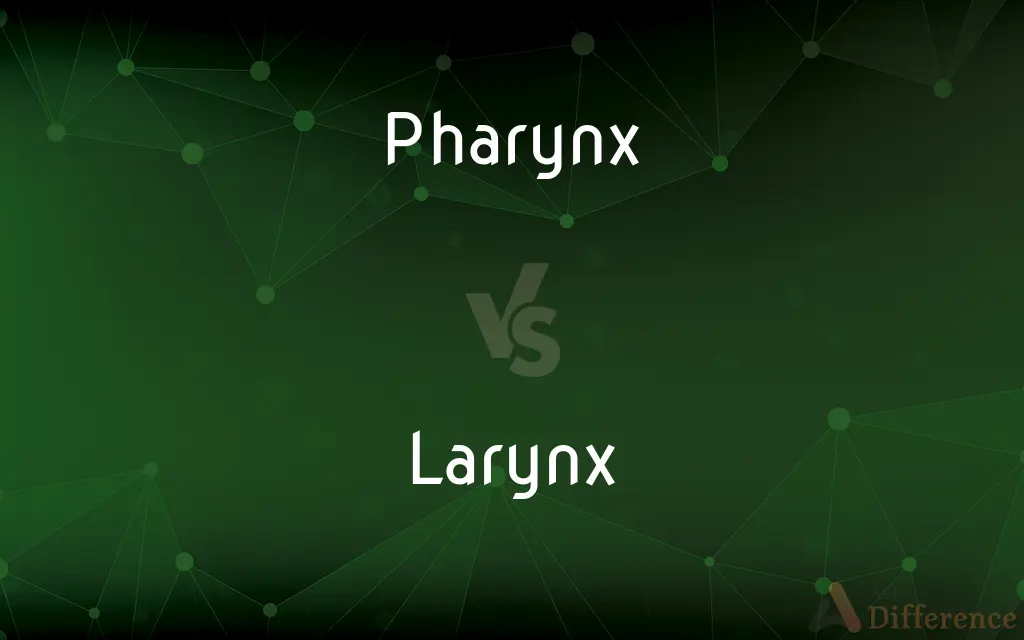Pharynx vs. Larynx — What's the Difference?
Edited by Tayyaba Rehman — By Fiza Rafique — Updated on September 24, 2023
The pharynx is a tube-like structure that connects the nose and mouth to the esophagus and larynx, serving as a passageway for air and food. The larynx, or voice box, sits below the pharynx and is responsible for sound production and airflow regulation.

Difference Between Pharynx and Larynx
Table of Contents
ADVERTISEMENT
Key Differences
The pharynx is an important anatomical structure that serves as a junction between the nasal and oral cavities and the esophagus and larynx. Its primary function is to act as a passage for both air and food. The pharynx is divided into three regions: the nasopharynx, oropharynx, and laryngopharynx, each serving a specific function.
The larynx, commonly known as the voice box, is located below the pharynx and is critical for vocalization. Unlike the pharynx, which serves multiple purposes including aiding in digestion and respiration, the larynx's primary function is related to sound production and the protection of the trachea.
Both the pharynx and the larynx play critical roles in the human respiratory and digestive systems. While the pharynx serves as a pathway for both food and air, the larynx specializes in sound production and acts as a protective gateway to the lungs, preventing food and other foreign objects from entering the trachea.
While the pharynx and larynx are anatomically connected, they are functionally distinct. The pharynx is more versatile in its functions, providing a passage for both food and air. The larynx, however, is specialized in functions related to vocalization and airway protection.
Comparison Chart
Meaning
Tube-like structure connecting nose and mouth to esophagus and larynx
Voice box located below the pharynx
ADVERTISEMENT
Function
Passage for air and food
Sound production, airway protection
Anatomy
Divided into nasopharynx, oropharynx, and laryngopharynx
Composed of cartilage, vocal cords
Grammar
Noun
Noun
Position
Above the larynx
Below the pharynx
Compare with Definitions
Pharynx
Part of both the digestive and respiratory systems.
The pharynx serves multiple physiological functions.
Larynx
A cartilaginous structure below the pharynx.
The larynx is located closer to the trachea.
Pharynx
A passageway for both air and food.
Food passes through the pharynx before reaching the esophagus.
Larynx
Acts as an airway protector.
The larynx prevents food from entering the trachea.
Pharynx
Divided into nasopharynx, oropharynx, and laryngopharynx.
The nasopharynx is the uppermost part of the pharynx.
Larynx
Contains vocal cords.
The vocal cords in the larynx are essential for speech.
Pharynx
A muscular tube that connects the nose and mouth to the esophagus.
The pharynx plays a role in both digestion and respiration.
Larynx
Also known as the voice box.
The larynx enables humans to speak.
Pharynx
The pharynx (plural: pharynges) is the part of the throat behind the mouth and nasal cavity, and above the oesophagus and trachea (the tubes going down to the stomach and the lungs). It is found in vertebrates and invertebrates, though its structure varies across species.
Larynx
Responsible for sound production.
The vocal cords in the larynx vibrate to produce sound.
Pharynx
The section of the digestive tract that extends from the mouth and nasal cavities to the larynx, where it becomes continuous with the esophagus.
Larynx
The larynx (), commonly called the voice box, is an organ in the top of the neck involved in breathing, producing sound and protecting the trachea against food aspiration. The opening of larynx into pharynx known as the laryngeal inlet is about 4–5 centimeters in diameter.
Pharynx
(anatomy) The part of the alimentary canal and respiratory tract that extends from the back of the mouth and nasal cavity to the larynx and esophagus.
Larynx
The part of the respiratory tract between the pharynx and the trachea, having walls of cartilage and muscle and containing the vocal cords enveloped in folds of mucous membrane.
Pharynx
(zootomy) The part of the alimentary canal immediately behind the mouth in invertebrates that may be thickened and muscular, eversible and toothed, or adapted as a suctorial organ.
Larynx
A hollow muscular organ of the neck of mammals situated just below where the tract of the pharynx splits into the trachea and the oesophagus. It is involved in breath control and protection of the trachea, and, because it houses the vocal cords, sound production.
Pharynx
The part of the alimentary canal between the cavity of the mouth and the esophagus. It has one or two external openings through the nose in the higher vertebrates, and lateral branchial openings in fishes and some amphibias.
Larynx
The expanded upper end of the windpipe or trachea, connected with the hyoid bone or cartilage. It contains the vocal cords, which produce the voice by their vibrations, when they are stretched and a current of air passes between them. The larynx is connected with the pharynx by an opening, the glottis, which, in mammals, is protected by a lidlike epiglottis.
Pharynx
The passage to the stomach and lungs; in the front part of the neck below the chin and above the collarbone
Larynx
A cartilaginous structure at the top of the trachea; contains elastic vocal cords that are the source of the vocal tone in speech
Pharynx
A junction for the digestive and respiratory tracts.
The pharynx links the mouth and nose to the respiratory and digestive systems.
Common Curiosities
Where is the larynx located?
It's located below the pharynx.
Where is the pharynx located?
It connects the nose and mouth to the esophagus and larynx.
What is the larynx?
The larynx, or voice box, is responsible for sound production and airway protection.
What is the pharynx?
The pharynx is a tube-like structure that serves as a passage for air and food.
What is the function of the larynx?
Its main functions are sound production and airway protection.
Are they involved in respiration?
Yes, both are part of the respiratory tract.
Can the pharynx and larynx be affected by disease?
Yes, conditions like pharyngitis and laryngitis can affect them.
Can surgery be performed on the pharynx or larynx?
Yes, for conditions like sleep apnea or vocal cord nodules.
What is the function of the pharynx?
It serves as a passage for both air and food.
What happens during laryngitis?
Inflammation of the larynx occurs, affecting your voice.
What is the nasopharynx?
It's the uppermost part of the pharynx, connected to the nasal cavity.
Do the pharynx and larynx contain cartilage?
The pharynx is mostly muscular, while the larynx contains cartilage.
Are the pharynx and larynx connected?
Yes, anatomically they are connected but serve different functions.
What protects the airway during swallowing?
The larynx prevents food from entering the trachea.
Do animals have a pharynx and larynx?
Yes, many animals have anatomically similar structures.
Share Your Discovery

Previous Comparison
Salutatorian vs. Valedictorian
Next Comparison
Response vs. RespondAuthor Spotlight
Written by
Fiza RafiqueFiza Rafique is a skilled content writer at AskDifference.com, where she meticulously refines and enhances written pieces. Drawing from her vast editorial expertise, Fiza ensures clarity, accuracy, and precision in every article. Passionate about language, she continually seeks to elevate the quality of content for readers worldwide.
Edited by
Tayyaba RehmanTayyaba Rehman is a distinguished writer, currently serving as a primary contributor to askdifference.com. As a researcher in semantics and etymology, Tayyaba's passion for the complexity of languages and their distinctions has found a perfect home on the platform. Tayyaba delves into the intricacies of language, distinguishing between commonly confused words and phrases, thereby providing clarity for readers worldwide.













































